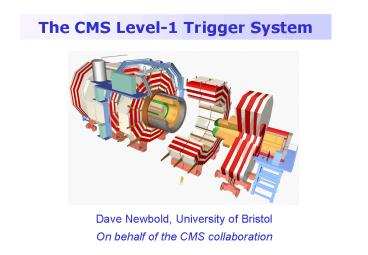The CMS Level1 Trigger System PowerPoint PPT Presentation
1 / 16
Title: The CMS Level1 Trigger System
1
The CMS Level-1 Trigger System
- Dave Newbold, University of Bristol
- On behalf of the CMS collaboration
2
Triggering at the LHC
- Tiny signals, huge background
- p-p inelastic rate GHz
- e.g. H(150) -gt gg lt mHz
- but bb MHz background!
- Complex events detector
- Typical CMS event is gt1MB
- Max storage rate 100MB/s
- Huge selectivity needed
- Trigger reduction factor 107
- L1 o/p rate lt 100kHz
- LHC collisions _at_ 40MHz
- Mean of 23 evts per BX at full luminosity
- Detector response time of flight are gt 1BX
3
Level-1 trigger strategy
- Driven by LHC physics conditions
- Decays of rare and heavy particles against large
soft QCD b/g - Many decays involve intermediate W / Z H -gt gg
also important - -gt Identify high-pt leptons and photons
(including t) - Low pt thresholds motivated by efficiency for W /
Z / light Higgs - Trigger combinations
- gt20GeV limit on single-lepton thresholds due to
quark decay p0 b/g - Most interesting states decay to two or more
trigger objects can use lower thresholds for
objects in combination - -gt Find trigger objects locally, combine and cut
only at last stage - Large uncertainties in background (and perhaps
signal) - Flexibility and control of rate are both vital
- -gt All trigger thresholds and conditions must be
programmable - Trigger architecture is fixed, but this is a
function of detector geometry - Must have high and well-understood efficiency
- -gt Need to include overlapping and minbias
triggers to measure e
4
Trigger / DAQ architecture
- Level-1 uses muon calo data only
- Tracking data too large / complex
- Local pattern recognition is possible
- Fully pipelined digital electronic system
- Physically impossible to make decision in 25ns
(speed of light) - All data stored on detector during fixed L1
latency, read out upon L1A - Memory constraints give max latency 3.2ms (of
which 2ms is cable delay) - Output of Level-1
- Single bit accept / reject
- Triggers may be throttled for technical reasons
but otherwise, zero deadtime - On L1A, data proceed via event builder switch to
High Level Trigger (see talk of G. Bagliesi)
5
Level-1 overview
6
Trigger system location
7
Calorimeter trigger detectors
- ECAL, HCAL cover to h 3, forward calorimeter
to h 5 - Trig prims group crystals / scintillators into (2
x) 32 x 72 trigger towers
8
Calorimeter trigger algorithms
9
Calorimeter trigger performance
- Full GEANT study
- Includes minbias background
- L1034 cm-2s-1
- Efficiencies
- For objects within fiducial acceptance
- Rates
- e/g dominated by jet (p0) background
- Steep curves allow good control of rate
10
Muon trigger detectors
- Dedicated RPC detectors
- Excellent time resolution for effective BX-ID
- Main DT and CSC detectors
- Excellent position resolution for accurate pt
reconstruction
11
Muon trigger algorithms
12
Muon trigger performance
- Efficiency for any muon gt3 GeV pt
13
Global trigger
- Global trigger implements a wide range of
triggers (incl. topological) - Example low lumi (L2.1033 cm-2s-1) trigger
selection shown above - Total rate balanced between e/g, jets, muons for
initial HLT input 50kHz - Rate safety factor 3, to account for
uncertainties in background
14
Physics efficiencies
- Typical efficiencies for preceding trigger table
_at_ L2.1033 cm-2s-1
15
Practical challenges
- Technology
- Pushing (todays) digital processing and comms
technologies to the limit - Cannot afford huge outlay on custom components
(-gt FPGAs) - System must last for 10 years obsolescence.
- Synchronisation
- Time-of-flight and detector response take many BX
- Subdetector timing and bunch-crossing ID will be
challenging - Reliability
- Level-1 trigger performs online selection cannot
correct mistakes - System must be highly reliable, all data taking
depends on it - But some parts will fail or degrade at some time
- Some components on detector -gt radiation,
magnetic field considerations - Simulation / configuration control / real-time
trigger optimisation - Trigger integration for CMS begins 2004 - the
real work starts now
16
Summary
- Triggering at the LHC will be hard
- Leptons / photons are the key
- CMS Level-1 trigger system currently under
construction - Reduces 40MHz BX rate to lt 50KHz L1A
- Very large digital logic system
- Uses calorimeter and muon information only
- Simulated performance shows good efficiency for
the interesting channels

